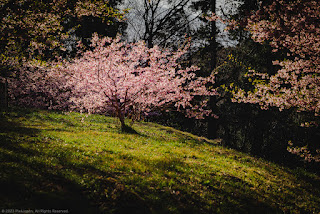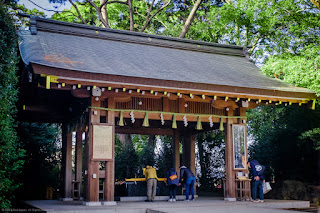Pentax K-1 II + DFA 28-105mm F3.5-5.6
48 mm ISO 100 for 1/1000 sec. at ƒ/11
Fujifilm X100V (23 mm) with 5% diffusion filter
ISO 250 for 1/13 sec. at ƒ/16
Velvia/Vivid film simulation
Cherry Blossoms & Mt. Fuji
Oimachi is a very small town near Odawara that features a park at the top of a small mountain that has a 19-hectare park of cherry trees supported and maintained by local volunteers.
Oi Yume-no-Sato Park is only about a 15-minute taxi ride from Shin-Matsuda Station on the Odakyu Line, or a 60- to 70-minute drive from Tokyo on the Tomei Expressway. Parking is available for free nearby at the farmers’ market.
Looking west from the peak of the park, you have a panoramic view that includes Kawazu-sakura cherry blossoms, which bloom between mid-February through early March, the neighboring town of Kaiseimachi, and a great view of Mt. Fuji.
Although the park has picnic tables, most visitors lay out a picnic blanket and enjoy a nice bento under the trees. The park was not crowded during my visit from about noon until sunset. This small and relatively unknown park allows you to take your time and enjoy the views, breath the fresh air, and enjoy the chirping of different birds feeding on the cherry blossom nectar.
The park is pet-friendly, has restrooms, a playground for children, and lots of space to walk around where you can get some nice photos without the huge crowds.
Pentax K-1 II + DFA 28-105mm F3.5-5.6
105 mm ISO 100 for 1/800 sec. at ƒ/16
Cherry Blossoms & First Quarter Moon
Oi Yume-no-Sato Park, located on a mountaintop above the town of Oimachi, Kanagawa Prefecture, is a quaint park known for its early-blooming cherry blossoms and grand view of Mt. Fuji.
In this shot, I was lucky to catch a clear shot of a half-illuminated moon during its first quarter phase.
Pentax K-1 II + DFA 28-105mm F3.5-5.6
58 mm ISO 100 for 1/400 sec. at ƒ/5.0
Fujifilm X100V (23 mm) with 5% diffusion filter
ISO 250 for 1/75 sec. at ƒ/2.8
Velvia/Vivid film simulation
Lone Young Cherry Blossom Tree
Oi Yume-no-Sato Park is located within a short 15-minute taxi ride from Shin-Matsuda Station on the Odakyu Line, or a 60- to 70-minute drive from Tokyo on the Tomei Expressway.
The park sits at an elevation of only 185 m, has many mature trees in addition to newly planted young trees that will grow into beautiful full-grown trees for future generations.
This shot is a good example of how much green, grassy areas the park has where visitors can throw down a picnic blanket and enjoy a hanami drinking party or a hanami bento lunch!
Pentax K-1 II + DFA 28-105mm F3.5-5.6
58 mm ISO 10,000 for 1/200 sec. at ƒ/20
Shades of Pink
From atop the peak of Oi Yume-no-Sato Park, you can enjoy a bird’s eye view of the stepped slope of early-blooming cherry blossoms.
If you wait until evening, you can enjoy varying shades of pink as the setting sun breaks through the nearby woodland trees.
Be forewarned that the park is surrounded by woodlands of cedar trees, so if you are like me, you should probably wear a mask or at least stock up on antihistamine medication if you suffer from hay fever!
Pentax K-1 II + DFA 28-105mm F3.5-5.6
28 mm ISO 100 for 1/30 sec. at ƒ22
Sunset, Cherry Blossoms, & Mt. Fuji
As the day drew to a close, the setting sun cast a beautiful glow over the blossoming Kawazu-zakura cherry blossoms at Oi Yume-no-Sato Park, marking the end of an unusually warm February day.
The temperature rapidly dropped with the onset of sunset, but the park was left with a warm hue that bathed the majestic Mt. Fuji in golden hour light.
Pentax K-1 II + DFA 28-105mm F3.5-5.6
95 mm ISO 100 for 1/20 sec. at ƒ/16
Fujifilm X100V (23 mm) with 5% diffusion filter
ISO 400 for 1/250 sec. at ƒ/2.0
Velvia/Vivid film simulation
Mt. Fuji at Twilight
As observed from Oi Yume-no-Sato Park in Oimachi, Kanagawa Prefecture, the sun appears south of Mt. Fuji as it sets.
During this time of the year, the park's viewpoint provides a stunning view of the southern slopes of Mt. Fuji, which are bathed in soft, warm colors, while the eastern and northern slopes retain cooler tones.
Despite the fading light, the cherry trees located higher up on the mountain slopes of the park are still visible as they bask in the ambient golden-hour light.
Copyright Notice for All Images:
© 2023 Pix4Japan. All rights reserved.
Unauthorized use for AI training is strictly prohibited.
Visit www.pix4japan.com for prints and licensed download options.

















































